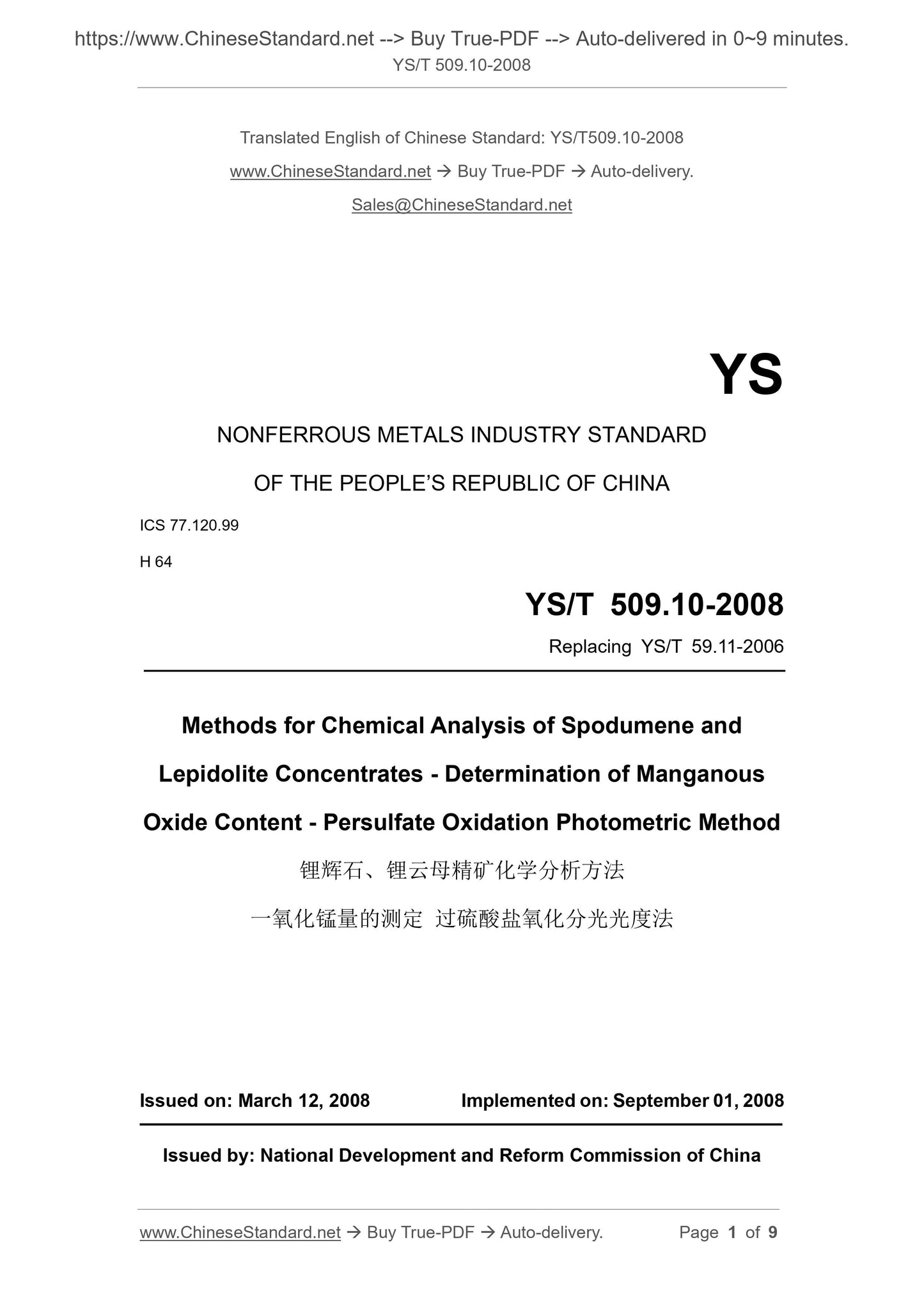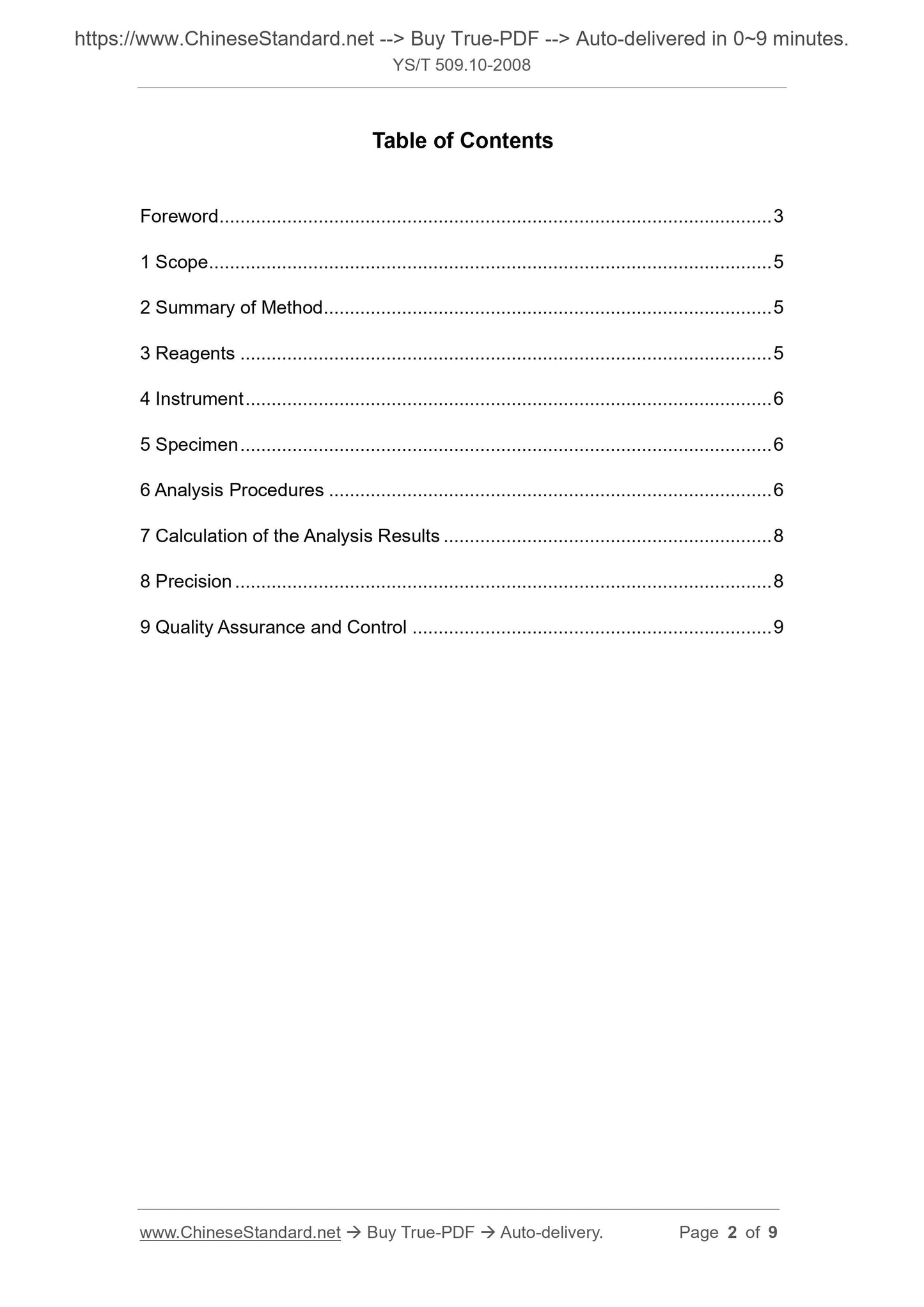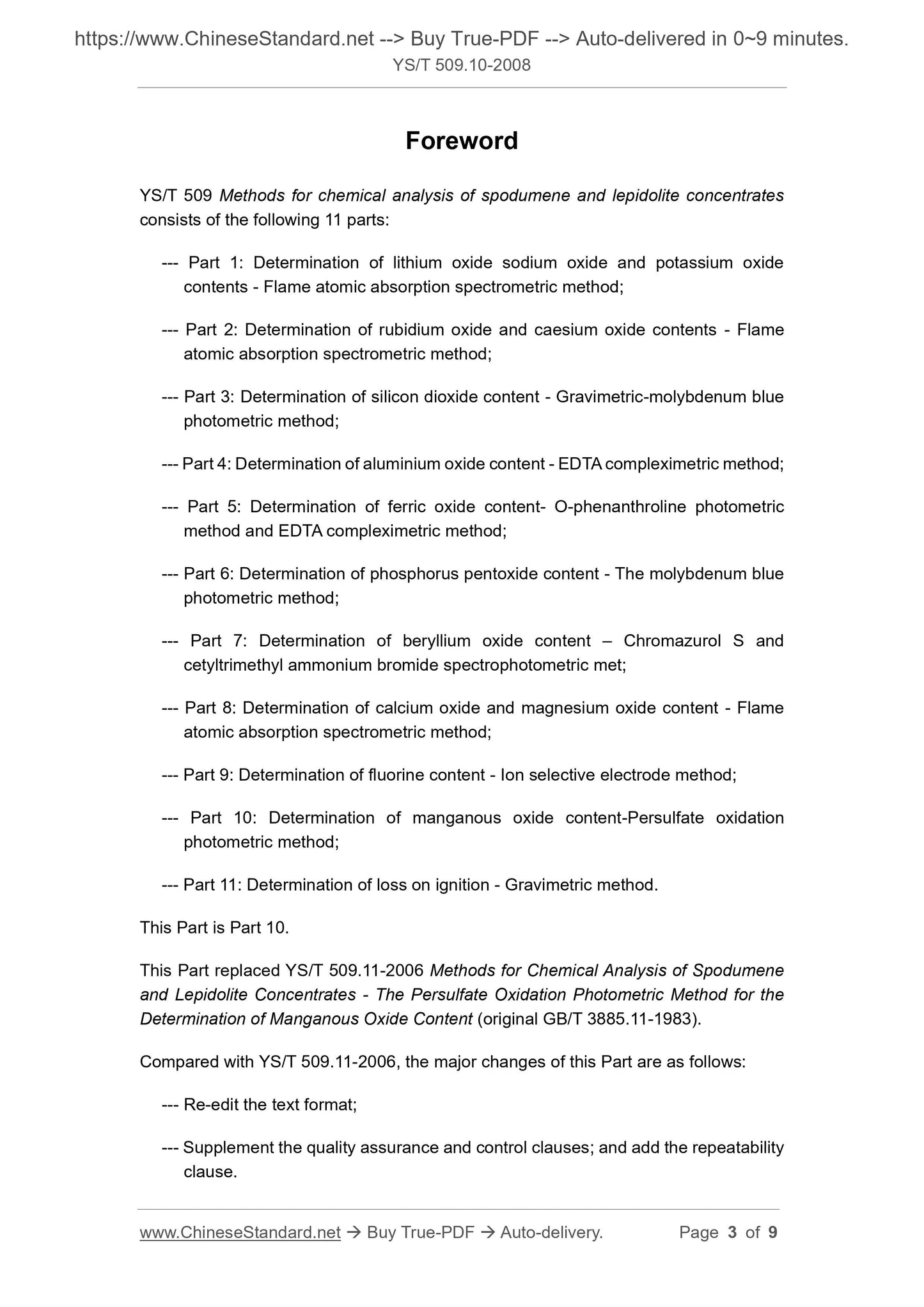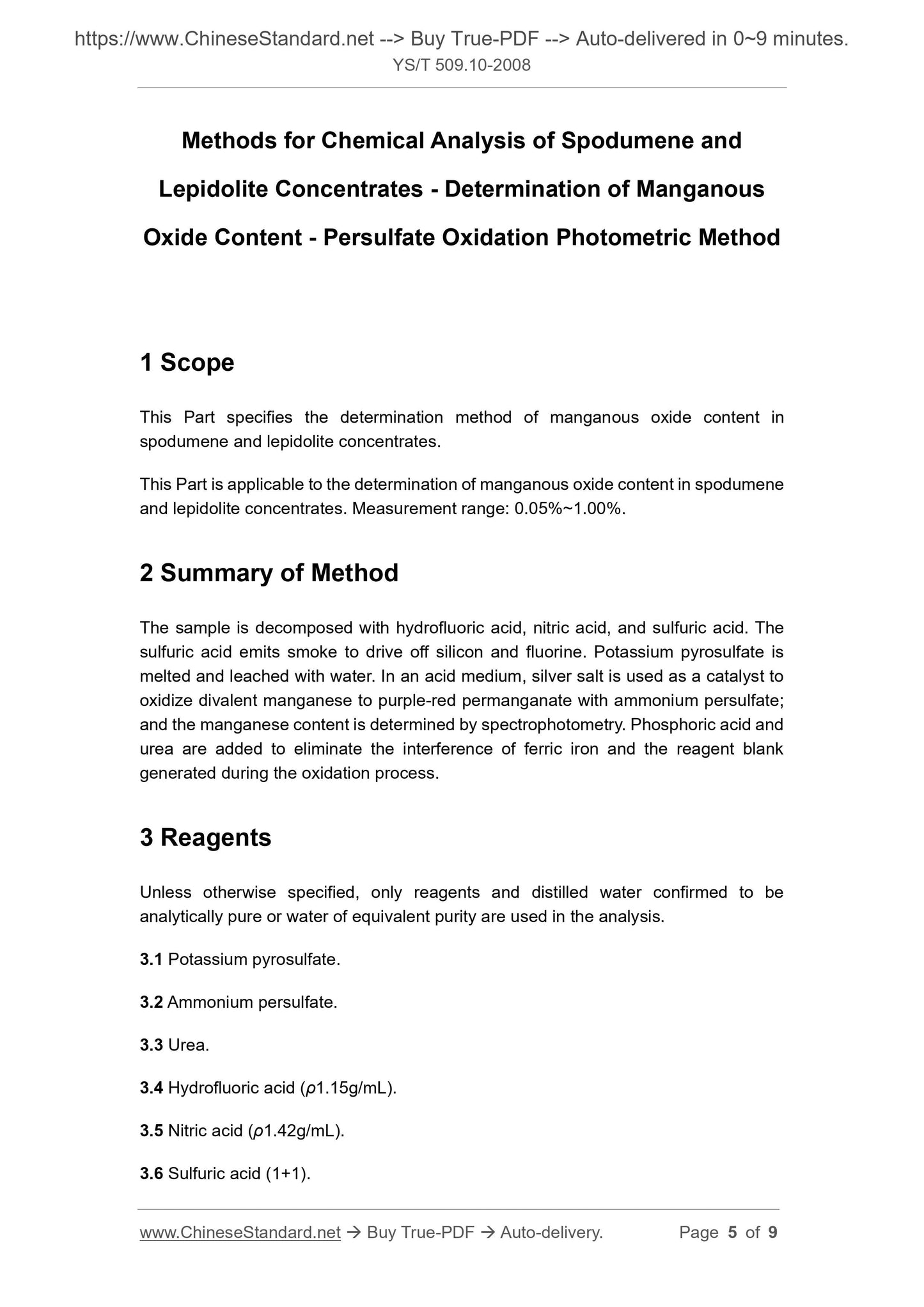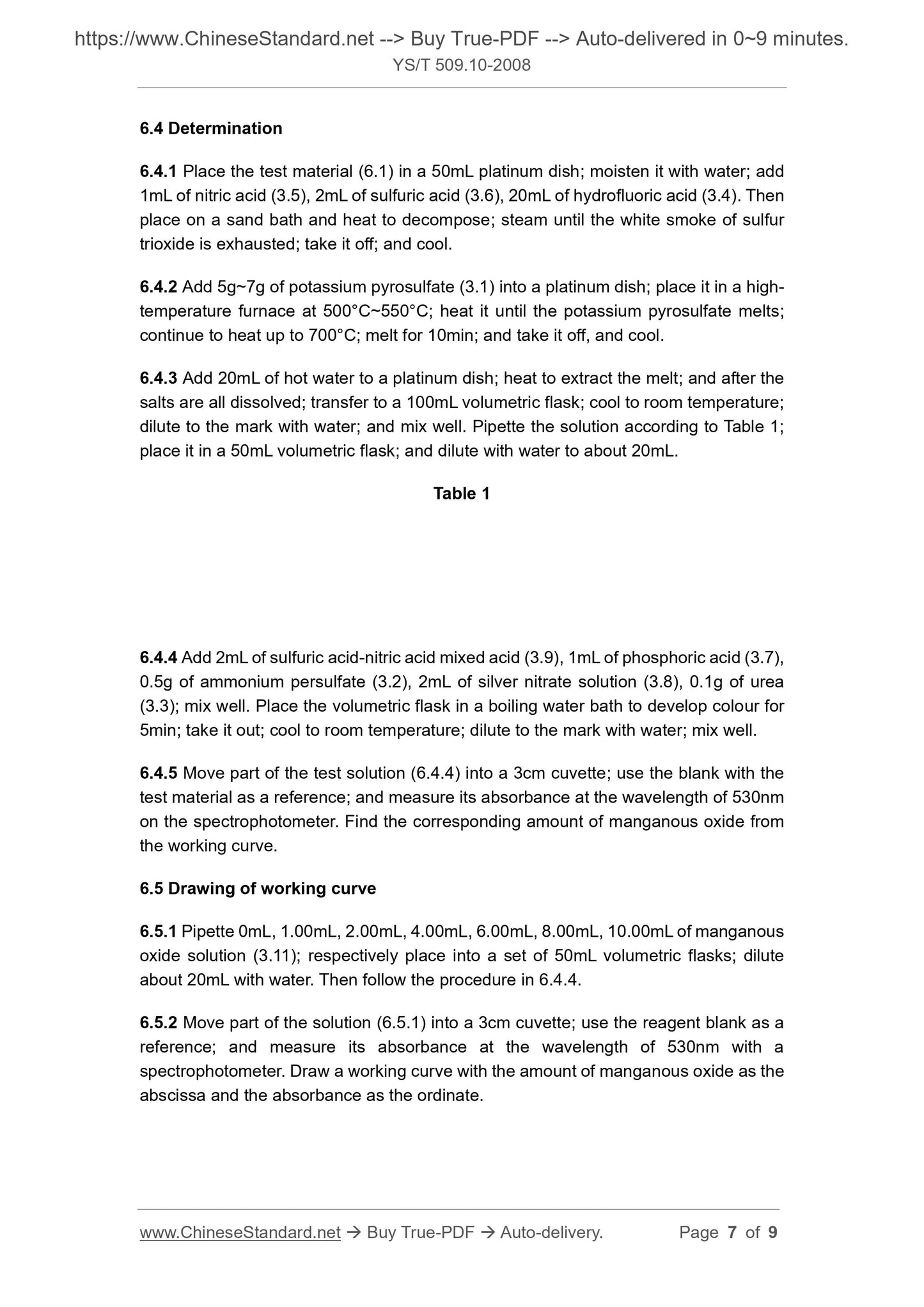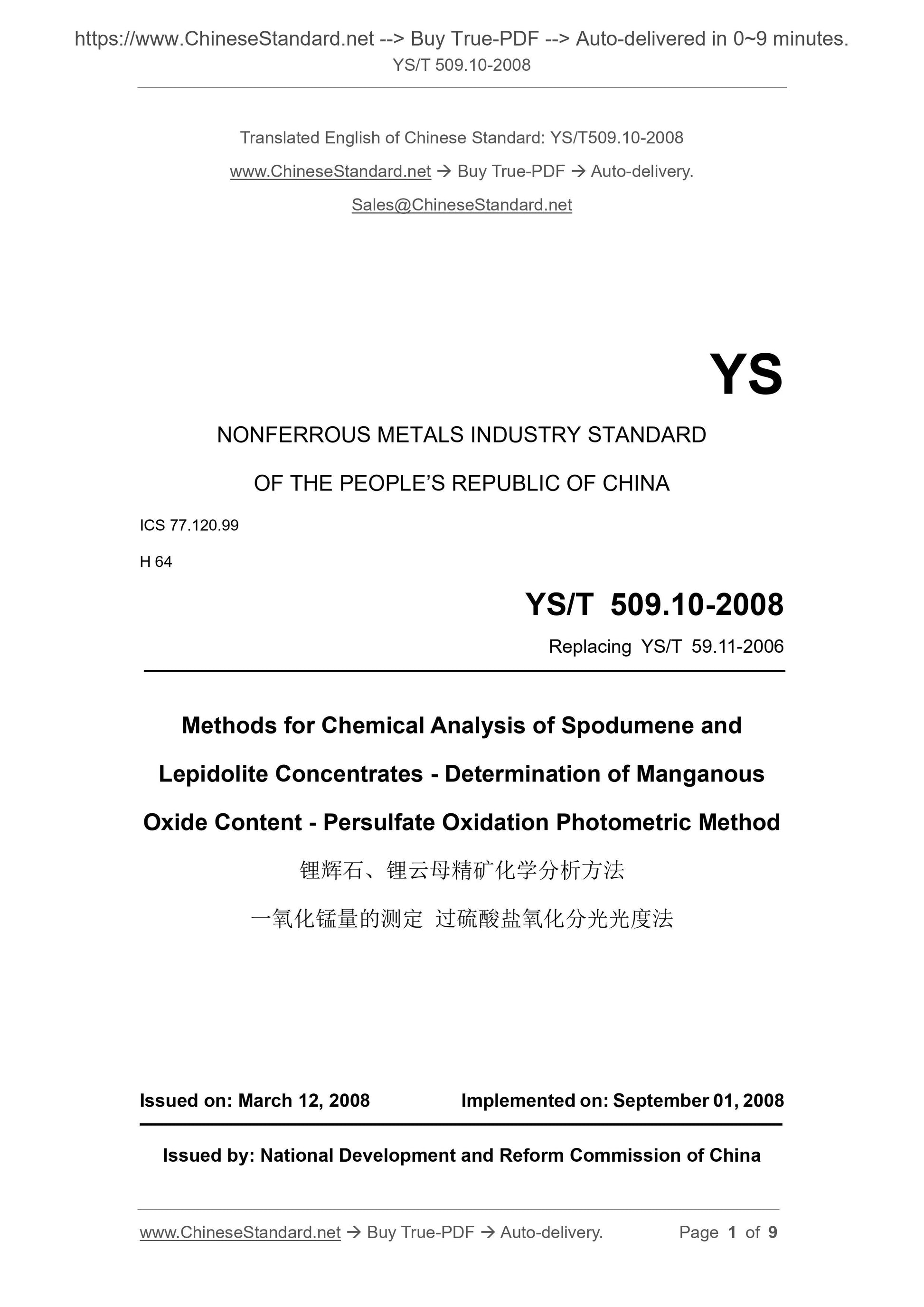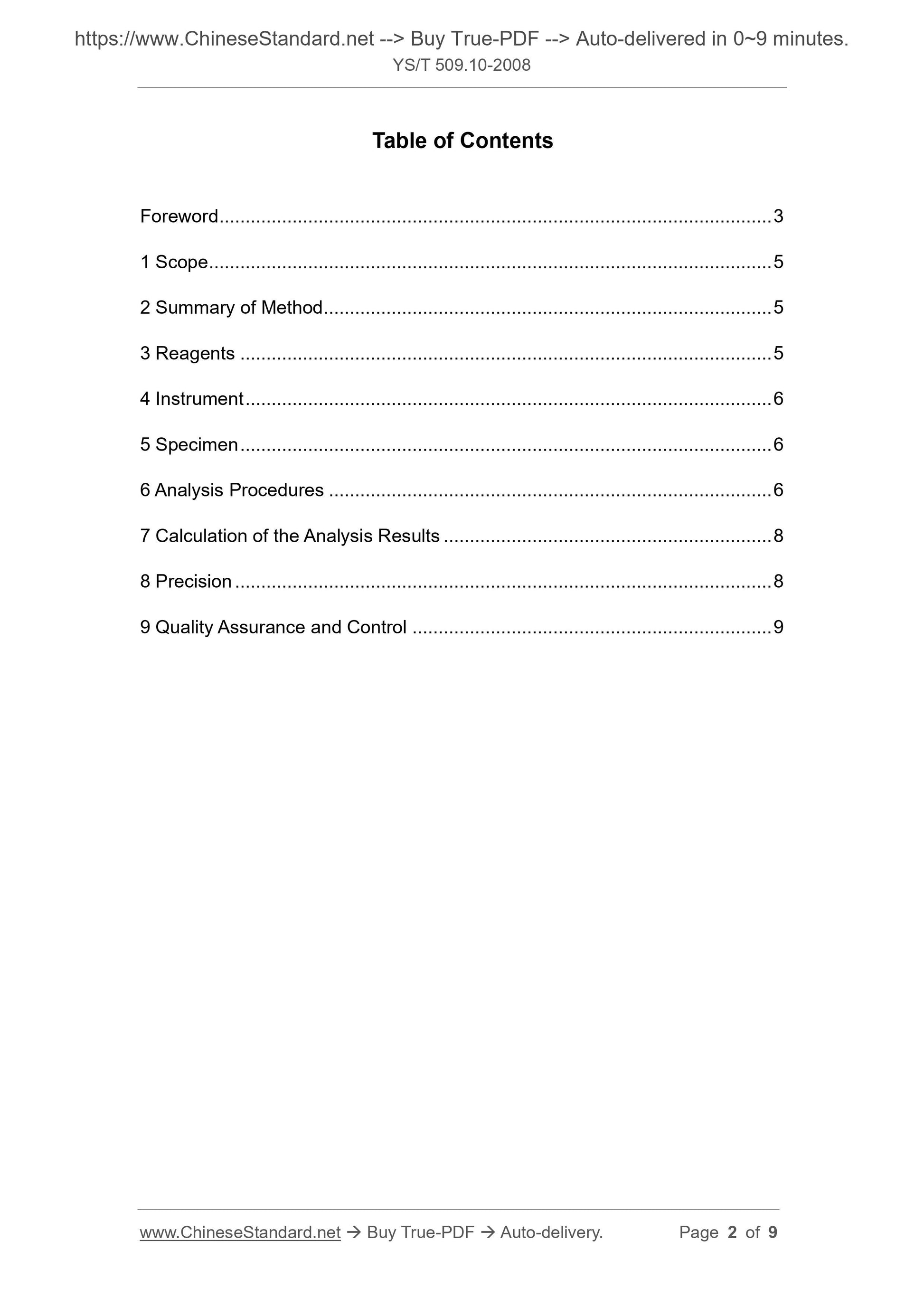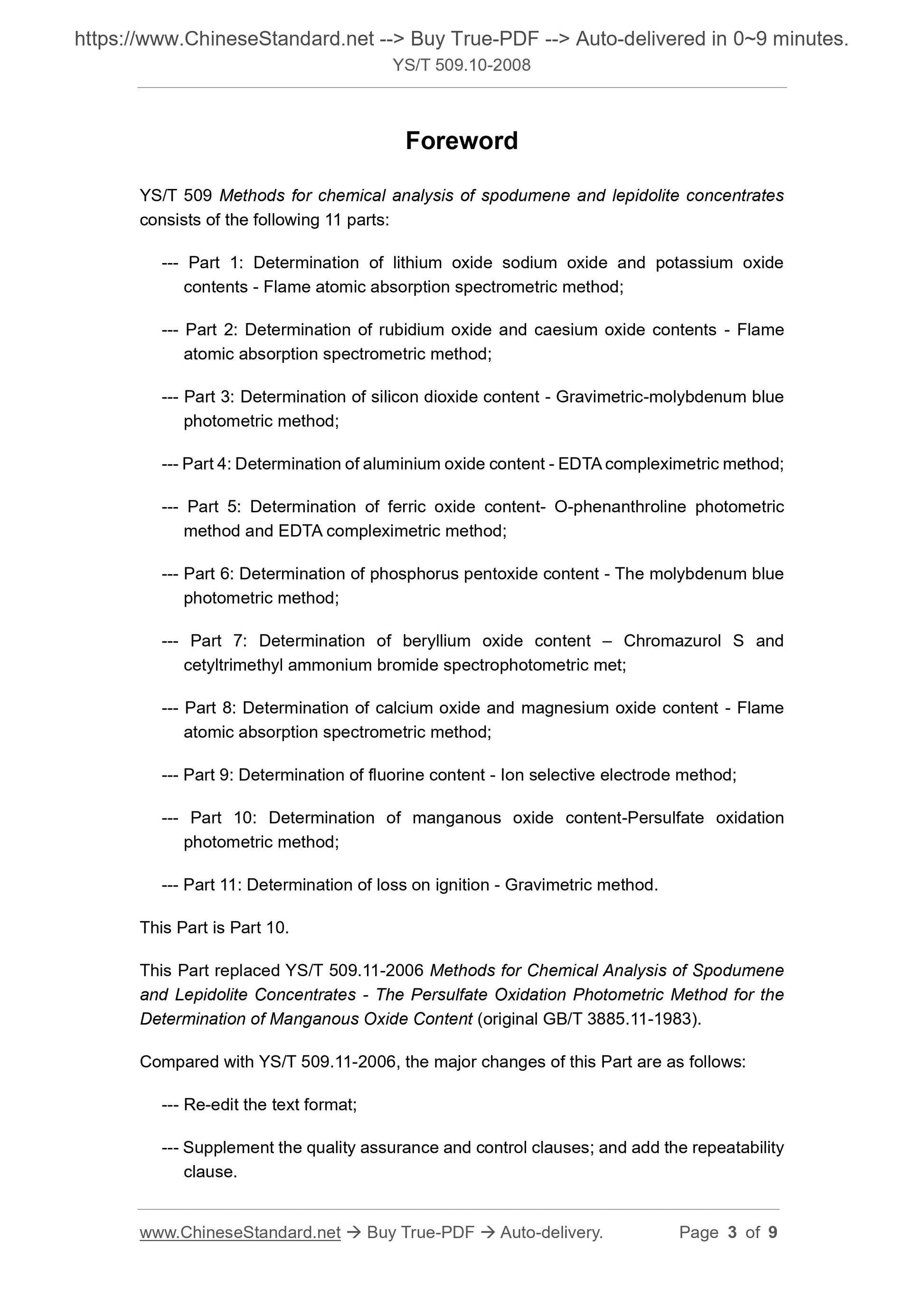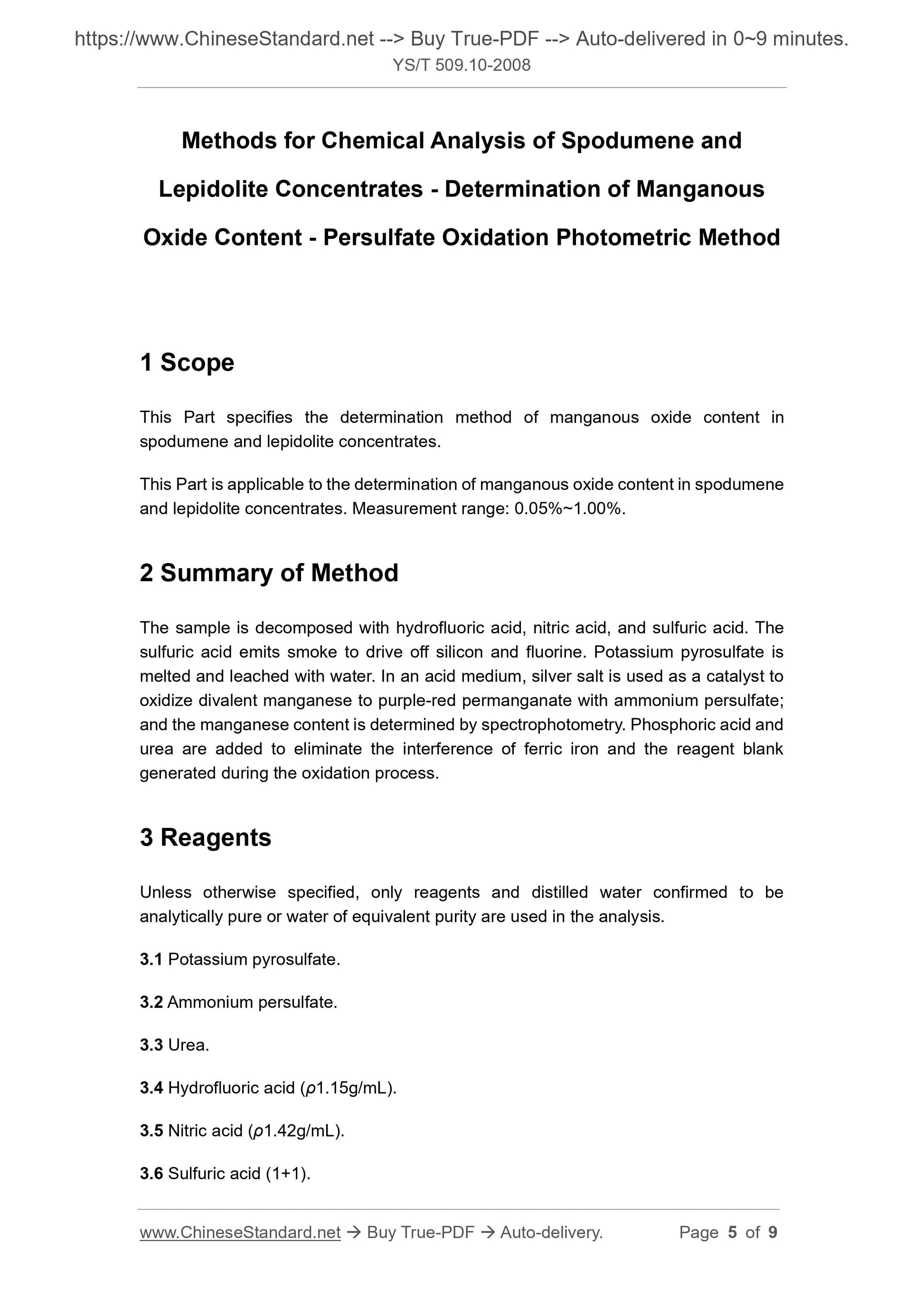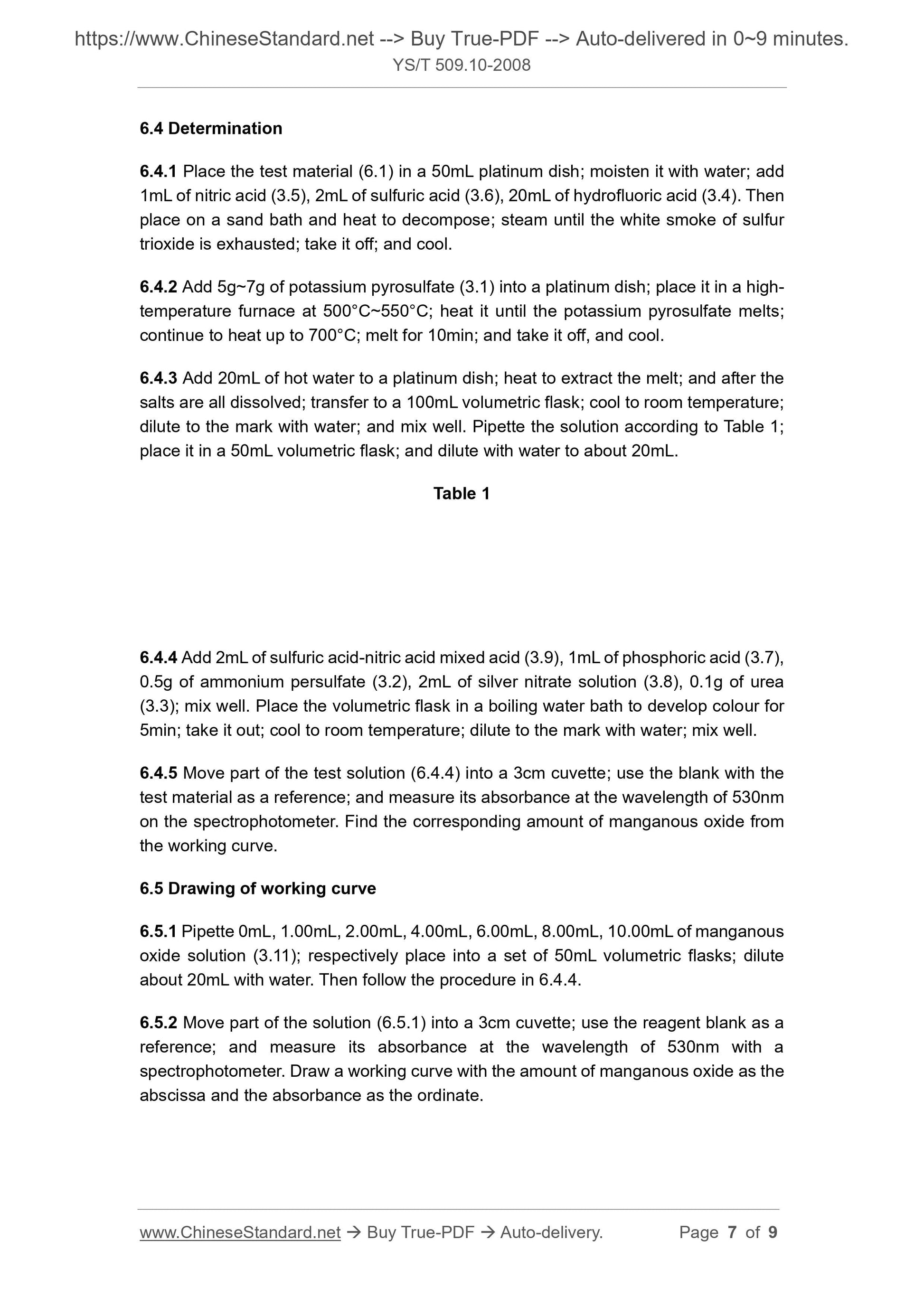1
/
af
5
PayPal, credit cards. Download editable-PDF & invoice in 1 second!
YS/T 509.10-2008 English PDF (YST509.10-2008)
YS/T 509.10-2008 English PDF (YST509.10-2008)
Normalpris
$150.00 USD
Normalpris
Udsalgspris
$150.00 USD
Stykpris
/
pr.
Levering beregnes ved betaling.
Tilgængelighed for afhentning kunne ikke indlæses
Delivery: 3 seconds. Download true-PDF + Invoice.
Get QUOTATION in 1-minute: Click YS/T 509.10-2008
Historical versions: YS/T 509.10-2008
Preview True-PDF (Reload/Scroll if blank)
YS/T 509.10-2008: Methods for chemical analysis of spodumene and lepidolite concentrates. Determination of manganous oxide content. Persulfate oxidation photometric method
YS/T 509.10-2008
YS
NONFERROUS METALS INDUSTRY STANDARD
OF THE PEOPLE’S REPUBLIC OF CHINA
ICS 77.120.99
H 64
Replacing YS/T 59.11-2006
Methods for Chemical Analysis of Spodumene and
Lepidolite Concentrates - Determination of Manganous
Oxide Content - Persulfate Oxidation Photometric Method
ISSUED ON: MARCH 12, 2008
IMPLEMENTED ON: SEPTEMBER 01, 2008
Issued by: National Development and Reform Commission of China
Table of Contents
Foreword ... 3
1 Scope ... 5
2 Summary of Method ... 5
3 Reagents ... 5
4 Instrument ... 6
5 Specimen ... 6
6 Analysis Procedures ... 6
7 Calculation of the Analysis Results ... 8
8 Precision ... 8
9 Quality Assurance and Control ... 9
Foreword
YS/T 509 Methods for chemical analysis of spodumene and lepidolite concentrates
consists of the following 11 parts:
--- Part 1: Determination of lithium oxide sodium oxide and potassium oxide
contents - Flame atomic absorption spectrometric method;
--- Part 2: Determination of rubidium oxide and caesium oxide contents - Flame
atomic absorption spectrometric method;
--- Part 3: Determination of silicon dioxide content - Gravimetric-molybdenum blue
photometric method;
--- Part 4: Determination of aluminium oxide content - EDTA compleximetric method;
--- Part 5: Determination of ferric oxide content- O-phenanthroline photometric
method and EDTA compleximetric method;
--- Part 6: Determination of phosphorus pentoxide content - The molybdenum blue
photometric method;
--- Part 7: Determination of beryllium oxide content – Chromazurol S and
cetyltrimethyl ammonium bromide spectrophotometric met;
--- Part 8: Determination of calcium oxide and magnesium oxide content - Flame
atomic absorption spectrometric method;
--- Part 9: Determination of fluorine content - Ion selective electrode method;
--- Part 10: Determination of manganous oxide content-Persulfate oxidation
photometric method;
--- Part 11: Determination of loss on ignition - Gravimetric method.
This Part is Part 10.
This Part replaced YS/T 509.11-2006 Methods for Chemical Analysis of Spodumene
and Lepidolite Concentrates - The Persulfate Oxidation Photometric Method for the
Determination of Manganous Oxide Content (original GB/T 3885.11-1983).
Compared with YS/T 509.11-2006, the major changes of this Part are as follows:
--- Re-edit the text format;
--- Supplement the quality assurance and control clauses; and add the repeatability
clause.
Methods for Chemical Analysis of Spodumene and
Lepidolite Concentrates - Determination of Manganous
Oxide Content - Persulfate Oxidation Photometric Method
1 Scope
This Part specifies the determination method of manganous oxide content in
spodumene and lepidolite concentrates.
This Part is applicable to the determination of manganous oxide content in spodumene
and lepidolite concentrates. Measurement range: 0.05%~1.00%.
2 Summary of Method
The sample is decomposed with hydrofluoric acid, nitric acid, and sulfuric acid. The
sulfuric acid emits smoke to drive off silicon and fluorine. Potassium pyrosulfate is
melted and leached with water. In an acid medium, silver salt is used as a catalyst to
oxidize divalent manganese to purple-red permanganate with ammonium persulfate;
and the manganese content is determined by spectrophotometry. Phosphoric acid and
urea are added to eliminate the interference of ferric iron and the reagent blank
generated during the oxidation process.
3 Reagents
Unless otherwise specified, only reagents and distilled water confirmed to be
analytically pure or water of equivalent purity are used in the analysis.
3.1 Potassium pyrosulfate.
3.2 Ammonium persulfate.
3.3 Urea.
3.4 Hydrofluoric acid (ρ1.15g/mL).
3.5 Nitric acid (ρ1.42g/mL).
3.6 Sulfuric acid (1+1).
6.4 Determination
6.4.1 Place the test material (6.1) in a 50mL platinum dish; moisten it with water; add
1mL of nitric acid (3.5), 2mL of sulfuric acid (3.6), 20mL of hydrofluoric acid (3.4). Then
place on a sand bath and heat to decompose; steam until the white smoke of sulfur
trioxide is exhausted; take it off; and cool.
6.4.2 Add 5g~7g of potassium pyrosulfate (3.1) into a platinum dish; place it in a high-
temperature furnace at 500°C~550°C; heat it until the potassium pyrosulfate melts;
continue to heat up to 700°C; melt for 10min; and take it off, and cool.
6.4.3 Add 20mL of hot water to a platinum dish; heat to extract the melt; and after the
salts are all dissolved; transfer to a 100mL volumetric flask; cool to room temperature;
dilute to the mark with water; and mix well. Pipette the solution according to Table 1;
place it in a 50mL volumetric flask; and dilute with water to about 20mL.
Table 1
6.4.4 Add 2mL of sulfuric acid-nitric acid mixed acid (3.9), 1mL of phosphoric acid (3.7),
0.5g of ammonium persulfate (3.2), 2mL of silver nitrate solution (3.8), 0.1g of urea
(3.3); mix well. Place the volumetric flask in a boiling water bath to develop colour for
5min; take it out; cool to room temperature; dilute to the mark with water; mix well.
6.4.5 Move part of the test solution (6.4.4) into a 3cm cuvette; use the blank with the
test material as a reference; and measure its absorbance at the wavelength of 530nm
on the spectrophotometer. Find the corresponding amount of manganous oxide from
the working curve.
6.5 Drawing of working curve
6.5.1 Pipette 0mL, 1.00mL, 2.00mL, 4.00mL, 6.00mL, 8.00mL, 10.00mL of manganous
oxide solution (3.11); respectively place into a set of 50mL volumetric flasks; dilute
about 20mL with water. Then follow the procedure in 6.4.4.
6.5.2 Move part of the solution (6.5.1) into a 3cm cuvette; use the reagent blank as a
reference; and measure its absorbance at the wavelength of 530nm with a
spectrophotometer. Draw a working curve with the amount of manganous oxide as the
abscissa and the absorbance as the ordinate.
Get QUOTATION in 1-minute: Click YS/T 509.10-2008
Historical versions: YS/T 509.10-2008
Preview True-PDF (Reload/Scroll if blank)
YS/T 509.10-2008: Methods for chemical analysis of spodumene and lepidolite concentrates. Determination of manganous oxide content. Persulfate oxidation photometric method
YS/T 509.10-2008
YS
NONFERROUS METALS INDUSTRY STANDARD
OF THE PEOPLE’S REPUBLIC OF CHINA
ICS 77.120.99
H 64
Replacing YS/T 59.11-2006
Methods for Chemical Analysis of Spodumene and
Lepidolite Concentrates - Determination of Manganous
Oxide Content - Persulfate Oxidation Photometric Method
ISSUED ON: MARCH 12, 2008
IMPLEMENTED ON: SEPTEMBER 01, 2008
Issued by: National Development and Reform Commission of China
Table of Contents
Foreword ... 3
1 Scope ... 5
2 Summary of Method ... 5
3 Reagents ... 5
4 Instrument ... 6
5 Specimen ... 6
6 Analysis Procedures ... 6
7 Calculation of the Analysis Results ... 8
8 Precision ... 8
9 Quality Assurance and Control ... 9
Foreword
YS/T 509 Methods for chemical analysis of spodumene and lepidolite concentrates
consists of the following 11 parts:
--- Part 1: Determination of lithium oxide sodium oxide and potassium oxide
contents - Flame atomic absorption spectrometric method;
--- Part 2: Determination of rubidium oxide and caesium oxide contents - Flame
atomic absorption spectrometric method;
--- Part 3: Determination of silicon dioxide content - Gravimetric-molybdenum blue
photometric method;
--- Part 4: Determination of aluminium oxide content - EDTA compleximetric method;
--- Part 5: Determination of ferric oxide content- O-phenanthroline photometric
method and EDTA compleximetric method;
--- Part 6: Determination of phosphorus pentoxide content - The molybdenum blue
photometric method;
--- Part 7: Determination of beryllium oxide content – Chromazurol S and
cetyltrimethyl ammonium bromide spectrophotometric met;
--- Part 8: Determination of calcium oxide and magnesium oxide content - Flame
atomic absorption spectrometric method;
--- Part 9: Determination of fluorine content - Ion selective electrode method;
--- Part 10: Determination of manganous oxide content-Persulfate oxidation
photometric method;
--- Part 11: Determination of loss on ignition - Gravimetric method.
This Part is Part 10.
This Part replaced YS/T 509.11-2006 Methods for Chemical Analysis of Spodumene
and Lepidolite Concentrates - The Persulfate Oxidation Photometric Method for the
Determination of Manganous Oxide Content (original GB/T 3885.11-1983).
Compared with YS/T 509.11-2006, the major changes of this Part are as follows:
--- Re-edit the text format;
--- Supplement the quality assurance and control clauses; and add the repeatability
clause.
Methods for Chemical Analysis of Spodumene and
Lepidolite Concentrates - Determination of Manganous
Oxide Content - Persulfate Oxidation Photometric Method
1 Scope
This Part specifies the determination method of manganous oxide content in
spodumene and lepidolite concentrates.
This Part is applicable to the determination of manganous oxide content in spodumene
and lepidolite concentrates. Measurement range: 0.05%~1.00%.
2 Summary of Method
The sample is decomposed with hydrofluoric acid, nitric acid, and sulfuric acid. The
sulfuric acid emits smoke to drive off silicon and fluorine. Potassium pyrosulfate is
melted and leached with water. In an acid medium, silver salt is used as a catalyst to
oxidize divalent manganese to purple-red permanganate with ammonium persulfate;
and the manganese content is determined by spectrophotometry. Phosphoric acid and
urea are added to eliminate the interference of ferric iron and the reagent blank
generated during the oxidation process.
3 Reagents
Unless otherwise specified, only reagents and distilled water confirmed to be
analytically pure or water of equivalent purity are used in the analysis.
3.1 Potassium pyrosulfate.
3.2 Ammonium persulfate.
3.3 Urea.
3.4 Hydrofluoric acid (ρ1.15g/mL).
3.5 Nitric acid (ρ1.42g/mL).
3.6 Sulfuric acid (1+1).
6.4 Determination
6.4.1 Place the test material (6.1) in a 50mL platinum dish; moisten it with water; add
1mL of nitric acid (3.5), 2mL of sulfuric acid (3.6), 20mL of hydrofluoric acid (3.4). Then
place on a sand bath and heat to decompose; steam until the white smoke of sulfur
trioxide is exhausted; take it off; and cool.
6.4.2 Add 5g~7g of potassium pyrosulfate (3.1) into a platinum dish; place it in a high-
temperature furnace at 500°C~550°C; heat it until the potassium pyrosulfate melts;
continue to heat up to 700°C; melt for 10min; and take it off, and cool.
6.4.3 Add 20mL of hot water to a platinum dish; heat to extract the melt; and after the
salts are all dissolved; transfer to a 100mL volumetric flask; cool to room temperature;
dilute to the mark with water; and mix well. Pipette the solution according to Table 1;
place it in a 50mL volumetric flask; and dilute with water to about 20mL.
Table 1
6.4.4 Add 2mL of sulfuric acid-nitric acid mixed acid (3.9), 1mL of phosphoric acid (3.7),
0.5g of ammonium persulfate (3.2), 2mL of silver nitrate solution (3.8), 0.1g of urea
(3.3); mix well. Place the volumetric flask in a boiling water bath to develop colour for
5min; take it out; cool to room temperature; dilute to the mark with water; mix well.
6.4.5 Move part of the test solution (6.4.4) into a 3cm cuvette; use the blank with the
test material as a reference; and measure its absorbance at the wavelength of 530nm
on the spectrophotometer. Find the corresponding amount of manganous oxide from
the working curve.
6.5 Drawing of working curve
6.5.1 Pipette 0mL, 1.00mL, 2.00mL, 4.00mL, 6.00mL, 8.00mL, 10.00mL of manganous
oxide solution (3.11); respectively place into a set of 50mL volumetric flasks; dilute
about 20mL with water. Then follow the procedure in 6.4.4.
6.5.2 Move part of the solution (6.5.1) into a 3cm cuvette; use the reagent blank as a
reference; and measure its absorbance at the wavelength of 530nm with a
spectrophotometer. Draw a working curve with the amount of manganous oxide as the
abscissa and the absorbance as the ordinate.
Share
